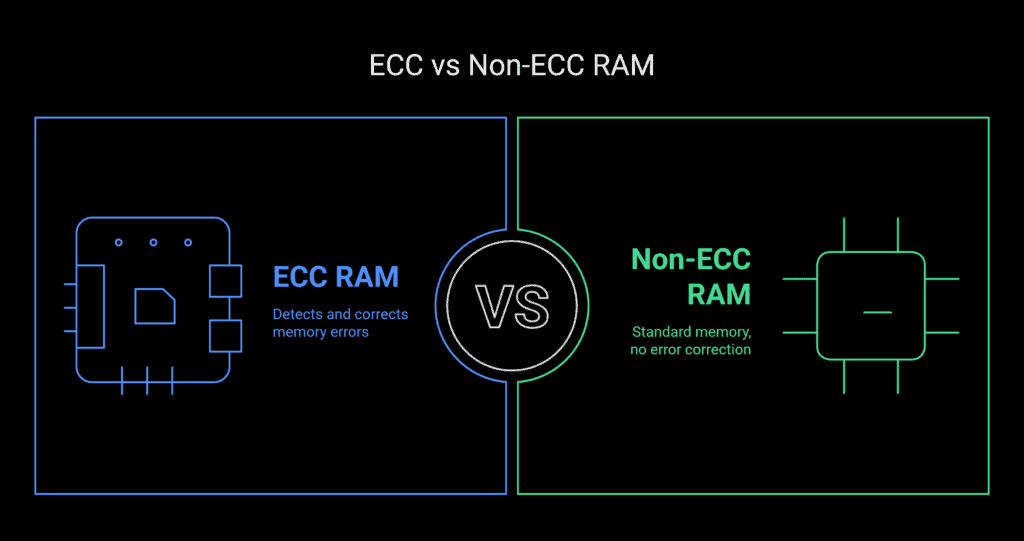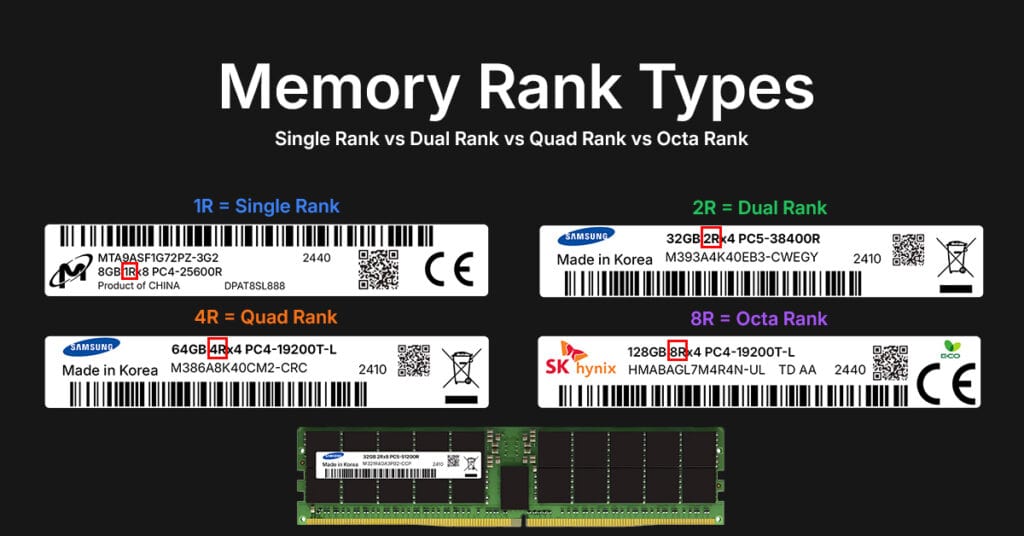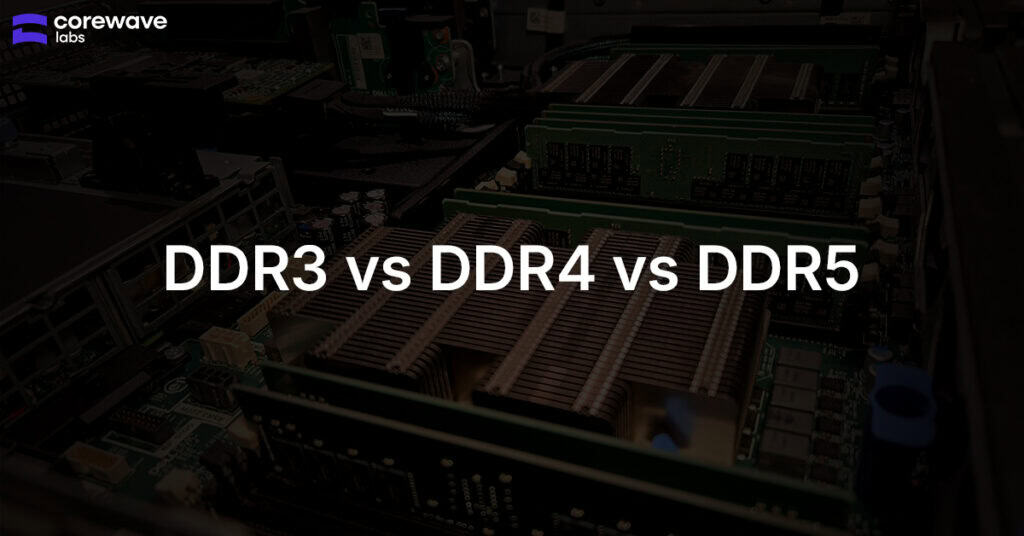Updated on:
| Written by:
ECC vs Non-ECC Memory: Differences, Use Cases & Benefits

Key Takeaways
- ECC (Error-Correcting Code) memory detects and corrects single-bit errors, reducing crashes and improving data integrity.
- ECC is ideal for servers, data centers, and mission-critical infrastructure.
- ECC memory typically adds a 2–3% performance overhead and costs 10–20% more than non-ECC RAM.
- ECC RAM requires compatible CPUs and motherboards to function correctly.
- Mixing ECC and non-ECC RAM is not recommended—compatibility issues are common.
- Non-ECC memory is faster and cheaper, but lacks error correction—suitable for general-purpose and consumer systems.
- Non-ECC is better for desktops, gaming, and budget-sensitive builds.
Introduction
RAM (Random Access Memory) keeps systems running fast and smooth by holding data your processor needs in real time. In environments like data centers or telecom infrastructure, its role is critical to uptime and reliability.
But not all RAM is created equal.
The choice between ECC vs non-ECC memory goes beyond speed or cost. It affects system stability, data integrity, and long-term performance. In this article, we’ll explain the key differences and help you weigh the trade-offs—reliability, performance, cost, and compatibility—so you can make the right call for your infrastructure.
What Is ECC Memory?
ECC (Error-Correcting Code) memory is a type of RAM that detects and corrects single-bit errors in real time. It includes an extra chip—often called the ninth chip—that stores error-checking data to maintain memory accuracy and system stability.
ECC is widely used in servers, data centers, and other mission-critical environments where even minor memory errors can lead to downtime or data corruption. While it adds a small performance overhead, ECC memory delivers a major gain in reliability—ideal for systems that can’t afford failure.
What Is Non-ECC Memory?
Non-ECC memory is standard RAM found in most desktops, laptops, and consumer devices. Unlike ECC, it doesn’t correct memory errors—it assumes data is clean and processes it without verification.
This lack of error-checking removes a small layer of latency, giving slightly faster memory access—typically just 1–2 nanoseconds quicker per transaction. In real-world terms, this may result in a modest performance gain (often under 2%) in workloads like gaming, media editing, or general multitasking.
Non-ECC RAM is also more affordable, costing 10–20% less than ECC modules and working with a broader range of consumer hardware. That makes it a go-to choice for non-critical systems where speed and budget matter more than fault tolerance.
Key Differences Between ECC vs Non-ECC Memory

One easy way to tell if you’re using ECC memory is to count the black memory chips on the module.
- ECC RAM usually has a chip count divisible by 9—that’s 8 for data and 1 extra chip for error detection and correction.
- Non-ECC RAM typically has 8 chips (or a number divisible by 8) and no extra chip for error checking.
That extra ECC chip acts like a safety net. If something goes wrong when data is stored or retrieved, it can catch and often correct the issue—helping to prevent crashes and silent corruption.
That physical difference reflects their deeper purpose. ECC vs non-ECC memory are engineered for different roles. The key trade-offs come down to error handling, system reliability, performance, cost, and hardware compatibility.
Below is a quick side-by-side comparison:
| Feature | ECC Memory | Non-ECC Memory |
|---|---|---|
| Error Management | Detects and corrects single-bit errors | No error detection or correction |
| Reliability | High stability, fewer crashes or corruptions | Lower stability in long-term or heavy-use environments |
| Performance | Slightly higher latency (1–2ns); ~2–3% overhead | Slightly faster due to no error-checking overhead |
| Cost | 10–20% more expensive | More budget-friendly |
| Hardware Compatibility | Requires ECC-compatible CPU and motherboard | Compatible with most consumer systems |
| Typical Use Cases | Servers, data centers, mission-critical workloads | Desktops, laptops, general consumer applications |
| Chip Count | count divisible by 9 | count divisible by 8 |
In short:
ECC memory is built for stability and fault tolerance in high-reliability environments. Non-ECC memory is designed for affordability and speed in everyday computing. Choosing the right one depends on how much risk your systems can tolerate.
Pros and Cons of ECC Memory
Pros
Cons
Pros and Cons of Non-ECC Memory
Pros
Cons
How to Decide: ECC vs Non-ECC Memory
The right choice depends on how much risk, cost, and system stability matter in your environment.
Choose ECC Memory if:
- You’re running mission-critical systems—like servers, virtualization, or high-availability databases
- You work in data centers, telecom infrastructure, or other environments where downtime is costly
- Data integrity is a top priority and even rare memory errors are unacceptable
- You’re building for long-term reliability with minimal crash risk
Choose Non-ECC Memory if:
- You’re building a desktop, laptop, or general-purpose system
- Your use case includes gaming, media work, or office applications
- You need to optimize cost and performance, and occasional memory errors are low risk
- You’re operating in a non-critical environment where system recovery is acceptable
Long-Term Value in Enterprise Systems
While non-ECC memory may save upfront costs, ECC delivers better return on investment over time by reducing crashes, downtime, and data loss. For organizations managing large-scale infrastructure, that added stability can translate into lower operational risk and more predictable system performance.
ECC vs Non-ECC Memory: Frequently Asked Questions
Is it important for RAM to have ECC?
ECC is important if you’re running critical systems like servers or workstations. It helps detect and fix memory errors, improving stability and reducing the risk of crashes.
What does ECC stand for?
ECC stands for Error-Correcting Code. It’s a memory technology used to detect and correct single-bit errors, mainly in servers and mission-critical systems.
What is ECC in memory?
ECC in memory refers to a built-in error-checking system that detects and corrects data corruption. It’s used in systems where uptime and data accuracy are essential.
What is ECC memory and non-ECC memory?
ECC memory corrects single-bit errors and boosts reliability. Non-ECC memory lacks this feature but offers slightly better performance and lower cost for consumer systems.
What is ECC RAM memory?
ECC RAM is a type of memory that can detect and correct data errors automatically. It’s commonly used in servers, data centers, and other high-reliability systems.
What is non-ECC memory?
Non-ECC memory is standard RAM used in most desktops and laptops. It doesn’t correct memory errors, making it faster and cheaper, but less reliable than ECC RAM.
Can I use ECC RAM in a non-ECC motherboard?
In most cases, no. ECC RAM requires a compatible motherboard and CPU. Installing it in a non-ECC system may disable ECC features or cause boot issues.
Can I mix ECC and non-ECC RAM?
Mixing ECC and non-ECC RAM is not recommended. Most systems won’t allow it, and if they do, ECC functionality is usually disabled, defeating its purpose.
Can server RAM be used for gaming?
Technically yes, but not ideal. Server RAM like ECC or registered memory often has higher latency and may not be supported by consumer motherboards.
Is ECC memory worth it?
ECC memory is worth it for servers or systems where reliability matters. For general consumer use, non-ECC is more cost-effective and delivers similar performance.
Do all motherboards support ECC RAM?
No. Only certain motherboards with ECC-compatible chipsets and CPUs support ECC RAM. Always check compatibility before installing.
Does ECC RAM really matter?
Yes, if you’re running mission-critical systems. ECC RAM reduces crashes and corrects data errors. For everyday use, the benefits are often unnecessary.
Final Verdict: Your Memory Strategy Matters
In high-performance computing, memory isn’t just a spec—it’s a strategy. Whether you’re building a server rack or refreshing a workstation fleet, the decision between ECC and non-ECC memory directly impacts your system’s reliability, cost-efficiency, and resilience.
For IT leaders and engineers, the key is alignment:
Match your memory choice to your risk tolerance, performance expectations, and the criticality of the workload.
- If you’re managing infrastructure where uptime and data accuracy can’t be compromised, ECC memory is the smart, strategic investment.
- For cost-conscious builds where performance per dollar matters more than error correction, non-ECC memory offers a lean and effective solution.
Either way, understanding the trade-offs ensures you’re not just buying hardware—but making informed decisions that support the long-term goals of your infrastructure.
About the Author

Edgars Zukovskis
Board Member | CoreWave Labs
14+ years of expertise helping telecom operators, datacenters, and system integrators build efficient, cost-effective networks using compatible hardware solutions.
Server Memory for Top Brands
Select Your Server Brand to Find Compatible Memory
Recommended Reads
Discover insights to power your infrastructure.

